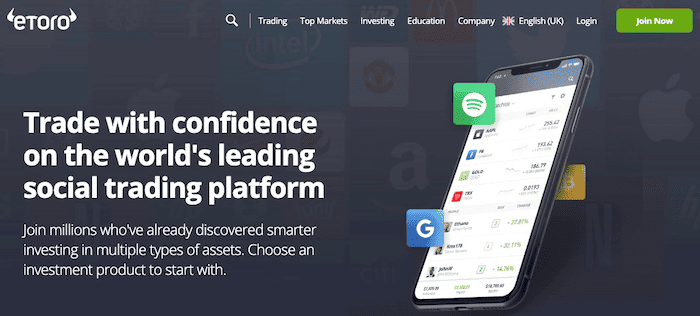The XTB Trading platform, originating from Poland, has offices in over 13 countries, including the UK, Spain, Chile, France, Germany, and Poland. It’s registered with the Financial Conduct Authority (FRN 522157), among other similar entities, and is regulated by CySEC in Cyprus. Additionally, it’s been listed on the Warsaw Stock Exchange since 2016.
Why Can You Trust This XTB Review?
I’ve been an XTB user for years, and I also hold a certification as an EFPA (European Financial Advisor), membership number #37363. I’ve thoroughly tested XTB, researching its advantages and drawbacks. I’m thrilled to offer you my seasoned perspective on this platform in the following guide.
Josep GarciaEFPA Financial Advisor
However, XTB may not be the right online broker for you. You’ll need to understand the assets they offer, their operation (e.g., order types), and their commission structure to decide.
Note: Please, be aware that XTB is available in most European countries like the UK, Italy, France, Spain, Germany or Poland. But if you’re based in the US, you won’t be able to trade with them, check out other alternatives.
XTB Review Verdict
XTB is a trading platform that is duly registered and regulated by several countries (including Cyprus, UK, Spain, Germany, Uruguay, etc.). The platform is highly flexible, catering to both novice and advanced investors/traders, with reasonably adjusted commissions.
It allows trading in CFDs on stocks, ETFs, cryptocurrencies, indices, and commodities. XTB also offers the possibility to invest in real stocks and ETFs in some European countries.
I have to say that it’s not the easiest solution to use. You can’t adjust the leverage (e.g. to reduce it), and its demo account is only available for 30 days (unless you’re a client, then it’s unlimited). For simpler online brokers, eToro or Trading 212 might be better options.
XTB Pros & Cons
Pros
Good Charts
Their system for interacting with full charts is among the most comprehensive. You can draw on these charts, compare asset prices with others like the S&P500, and apply analysis tools such as Bollinger Bands or Moving Averages.
News Feed & Economic Calendar
They offer a section where you can find economic and financial news relevant to your investments, and an economic calendar to remind you of the most important (economic and financial) events (e.g. macroeconomic data releases).
Accoun Currencies (GBP, EUR or USD)
You can trade with XTB using an account set up in GBP, EUR, or USD, depending on your linked bank account’s currency.
Flexible Alerts
The alert and notification system is flexible; you can request notifications for activities such as opening or closing positions, making deposits or withdrawals, and receiving asset price alerts. These notifications can be received by email, live on the platform or on your phone.
FCA Regulated
This European broker, is registered by many governmental bodies, such as the Financial Conduct Authority (FRN 522157) in the UK, CNMV in Spain, CySEC in Cyprus, BaFin in Germany, and AMF in France.
Opening an Account
Opening an account with XTB is straightforward; you just provide an email address and password, and upload the requested personal information (e.g., your ID and phone number). The entire process is 100% online.
CFD and Securities Trading
You can trade CFDs (ideal for traders), as well as stocks and real ETFs (suited for medium to long-term investors).
Fractional & Full Assets
XTB allows you to trade fractional slices of ETFs and stocks, or the whole asset if you prefer.
Cons
Not the Easiest
XTB offers a comprehensive platform, you won’t miss any options. However, this complexity makes it less user-friendly. The design, though, is modern and appealing.
Information Hard to Find
Occasionally, details about fees or trading processes are unclear, as offerings vary by country.
Limited Demo Account
XTB’s demo account is quite limited. Ideally, XTB would offer a non-expiring demo account. Once you’re a client, demo account access is unlimited.
Fixed Leverage
Unfortunately, it’s not possible to adjust leverage in derivative trading. I prefer the leverage flexibility that eToro provides.
XTB in Detail
Is XTB Safe?
I get the impression XTB’s platform is secure. You can set up notifications to receive alerts on your mobile phone or email whenever a position is opened or closed, or when funds are withdrawn. This way, you’re informed of any suspicious activity.

Withdrawals can only be made to a bank account in your name, which I imagine adds extra security.
I’d like to see a 2-step authentication system allowing confirmation of access to the XTB platform with a code sent to your phone, like by SMS or in the app.
Who Regulates XTB?
XTB is a trading platform of European origin, based in Poland, and it is regulated by multiple countries. As mentioned previously, it is also regulated by the UK’s Financial Conduct Authority, and others.
However, XTB is not solely registered with the FCA; it is also subject to regulation and registration by other agencies in various countries, including:
- ACP of the Banque de France
- German BanFin
- Spanish CNMV
- The Financial Conduct Authority of the United Kingdom
- KNF of Poland
- National Bank of the Czech Republic
- Or the CMVM of Portugal
- Central Bank of Uruguay
Additionally, XTB has offices in 13 countries, including the UK, Spain, Poland, Germany, France, and Chile.
XTB's Fees & Commissions
As you may already know, the commissions you face when investing can have a big (negative) impact on your profits.
However, if the commissions were higher, and you paid an average of 1.50%, you would have paid around £11,750 in commissions at the end of 25 years (assuming compound interest).
Traders have to deal with a lot of commissions (more specifically spreads), as they follow the market trend and open and close positions very frequently. That is why the difference between a low-fee broker and an expensive one can mean a lot of money.
You will face 2 types of commissions: operational; related to opening and closing positions, and non-operational.
Non-Operational XTB Fees
There are several commissions you may have to pay when you have an XTB account. Here are the details:
- Inactivity: If you don’t trade with XTB for 12 months you’ll have to pay $10. Trading is defined as opening or closing positions.
- Withdrawal: Withdrawing funds from XTB is free if your withdrawal is more than $60. If the amount you withdraw is less than $60, there is a commission fee.
- Deposits: There are generally no commissions for deposits you make. You may face a commission fee if you use an electronic payment method such as PayPal and Skrill – charged by the payment processor and not XTB.
It’s positive that with XTB there are no commissions for opening or maintaining an account, one less cost to worry about.
XTB’s Operating Fees
On the contrary, every time you trade a new position, you’ll face commissions (and/or spreads). Generally XTB has quite competitive commissions, the following are the commissions for the Standard account, if you have a Pro account these may be a bit lower.
- Commissions on asset purchases: In 2020, XTB started to offer the possibility to buy stocks and ETFs without commissions, but as we have said, these assets are only available in some European countries (not in the UK).
- Spreads: If you end up trading CFDs, you’ll not have a commissions fee, but you’ll have to deal with the spread. This is the difference between the bid price and the ask price at XTB, which is how derivatives brokers are usually funded.
- Exchange rate commissions: Your account can be in euros, pounds or US dollars, if you make deposits in other currencies you’ll have to pay an exchange rate commission. Similarly, if you invest in an asset that is traded in a currency other than your account currency you’ll also face a commissions fee, which in most cases is 0.5%.
Example Of Commissions With XTB
As an example, I will compare XTB’s commissions with some of its alternatives to give you an idea of how much it will cost you to trade with them.
| XTB Spread | XTB Daily Swap Points | |
|---|---|---|
| GBPUSD | 0.00022 | -3.664 (long)
-3.138 (short) |
| US30 | 2 | N/A |
| UK100 | 1.1 | N/A |
| Oil | 0.04 | N/A |
| Gold | 0.3 | -8.197 (long)
-7.192 (short) |
| Apple | 0.08%
(min. £8) |
-2.62725% (long)
-2.37275% (short) |
| Barclays | 0.08%
(min. £8) |
-2.52675% (long)
-2.47325% (short) |
| More information | www.XTB.com | |
* Please note that commissions fluctuate, the table above refers to commissions as of 24 January 2023.
Products You Can Trade With XTB
The fact that XTB has low spread and is a platform with one of the best chart analysis and news feeds is very positive. However, if XTB doesn’t allow you to trade the assets you’re interested in, it may not be a viable option for you, right?
In the following paragraphs, I will break down which assets you can invest in using XTB and which markets it will give you access to:
CFDs (Contracts For Difference)
One of the most popular products with XTB is CFDs, or Contracts For Difference. The prices of these are derivative financial assets that are linked to the price of another asset (called the underlying).
Technically, we could have CFDs on any asset. For example, if you and I were to agree, we could create a CFD on the price of bread or even the price of a bus pass.

Let’s see which CFDs you can invest in with XTB:
- Stocks: With XTB you can invest in real stocks, or you can do so with the CFD version of these. You can trade CFDs on major companies in the US and Europe.
- ETF: On the other hand, it’s also possible to invest in CFDs of the ETFs mentioned above.
- Forex: Surely currency pairs trading is one of the most popular CFDs. XTB have a lot available, about 50 popular pairs (e.g. EUR, USD, MXN JPY or GBP), but they also have some less common currencies like BRL or TRY.
- Indices: Another way to trade CFDs is to trade entire indices, which is also possible with XTB. You can trade the main European indices (e.g. SPA35 or UK100), American indices (e.g. US30 or BRAComp) and other regions such as Japan, Hong Kong, Australia or South Korea. In total, they have more than 20.
- Commodities: With XTB you can trade CFDs whose underlying asset is linked to a commodity. There are many available in various sectors: agriculture (e.g. sugar or coffee), energy (e.g. natural gas or oil), precious metals (e.g. gold or palladium) and industrial metals (e.g. zinc or copper).
- Cryptocurrencies: With the boom in cryptocurrencies, many market makers (such as XTB) have started to offer CFDs linked to the price of these assets. With XTB you can buy CFDs on around 25 cryptocurrencies such as Bitcoin, Dash or Ripple.
Shares & ETFs
XTB allows you to invest in real stocks and ETFs in several European countries. This option is ideal for investors who aim to trade securities of specific companies over the medium to long term.
You will have access to a diverse selection of 3,000 + stocks across various markets. For instance, you can explore shares of leading companies in the United States and major European nations, including Switzerland, Spain, Germany, France, the United Kingdom, and the Nordic countries.
XTB stands out as one of the brokers I have used, offering an extensive collection of more than 150 +. These ETFs are sourced from reputable managers such as iShares, Vanguard, SPDR, and Lyxor.
What Assets Can You Not Find On XTB?
Unfortunately, there are several assets that you won’t be able to trade on XTB, the most important of which include:
- Equities and ETFs outside some countries in Europe and UK
- Investment funds
- Cryptocurrencies: check eToro for cryptocurrencies
- Fixed income assets
- Derivatives (other than CFDs) such as warrants, options or futures.
How To Open An Account With XTB
Opening an account with XTB is a fairly straightforward process, but I want to guide you through it for clarity:

- Go to www.XTB.com and click on “Demo” – I always recommend starting by exploring the demo account to become familiar with it.
- Provide your email address, country of residence, and review and accept the terms of use.
- Enter your personal information, including your name and phone number. Select the platform you wish to use, choose the account type, and set your password.
That’s it! You can now access the XTB demo account and become acquainted with its interface and features.
If, after a few days, you feel prepared to begin investing with real funds, follow these steps to open a live account:
- Log in to your XTB Demo Account and click on “Open Real Account.” If you don’t have a demo account, visit XTB and click on “Become a Client”.
- Provide your email address and agree to XTB’s terms of use.
- Complete your personal details, including your date of birth and other necessary information.
- Specify your postal address.
- Respond to the questions regarding your investor profile.
- Confirm your email address and phone number. Upload any documents XTB may request, typically your passport – you can do this by uploading a photo online.
- Make your initial deposit and commence your investment journey.
Tax Management With XTB
They may withhold taxes on the profits you make, depending a little on the country you trade from and the type of asset you invested in.
XTB stores your trading information, so you should be able to compile your profits and losses for tax purposes. But remember, you’re responsible for all of this.
XTB Alternatives
Certainly, XTB is a one of the best brokers that can be a suitable choice for many users. However, there are instances where this Polish trading platform may not be the optimal selection. Therefore, allow me to introduce a couple of alternative services:
Trading 212

Trading 212 (read our review) is an online brokerage that offers a user-friendly trading platform accessible via a smartphone or web browser. This broker allows you to trade ETFs, stocks, and CFDs across various instruments, including stocks, indices, forex, and commodities. Currently, they do not impose fees for trading ETFs and shares. The only drawback is that they could expand their range of assets, as some instruments and markets are currently missing.
eToro

eToro is a prominent online broker boasting approximately 32 million users, making it stand out among many other investment platforms. Similar to XTB, eToro offers CFD trading, but it also provides the opportunity to invest in fractional (real) stocks and ETFs. Additionally, eToro embraces the cryptocurrency market, allowing you to ride the wave of digital assets. If you’re interested in social trading and wish to replicate the trades of others, eToro provides this option as well.
XTB Review: Final Thoughts
Alright, after this detailed guide and sharing my opinions on XTB, you should have a pretty good idea of when it’s appropriate to use this trading platform.
But let me provide you with a brief summary of the most important points to consider:
- It’s an ideal broker for individuals looking to invest on CFDs and real Stocks and ETFs. Its spreads are competitive and cover a wide range of markets, including Forex, indices, cryptocurrencies, and commodities, among others.
- It’s a registered platform with the FCA, ensuring that it’s not involved in any financial scams. Additionally, it’s registered with other European regulatory organizations.
- XTB’s platform offers some of the most useful charting tools I’ve ever tested; you can even draw on these charts.
- Opening an account with them is a straightforward process.
However, there are some factors to consider that may not be entirely positive:
- While it’s true that you can invest in real stocks and ETFs in some countries, other brokers like DEGIRO may offer more variety.
- Although its platform is feature-rich, it can be somewhat complex for beginners due to the numerous options available.
- If you trade CFDs, keep in mind that you won’t have the ability to reduce leverage. This means that your losses may be greater due to the effects of leverage. Ensure you have a clear understanding of this concept.
- XTB demo account is limited to 30 days of practice, unless you’re an existing client.
That concludes my overview of XTB. If you still have any questions, please feel free to leave a comment, and I’ll do my best to provide answers.
Frequently Asked Questions
XTB is a trading platform that allows its users to invest in CFDs of indices, stocks, Forex, cryptocurrencies, and commodities. Additionally, XTB offers the option for investors to purchase real stocks and ETFs, in case CFD trading is not your preference.
This broker is regulated by the British Financial Conduct Authority (among others) and provides a diverse range of investment products. It’s worth noting that while XTB offers a comprehensive set of features, including charting tools, which experts will appreciate, beginners may initially find it overwhelming. Please be aware that when trading with CFDs, the leverage cannot be reduced.
XTB was founded in Poland by Jakub Zablocki, who remains an integral part of the company to this day.
Currently, XTB is a publicly traded broker, which means that anyone interested in purchasing shares can become a part-owner of XTB.

However, as evident from the previous image, the founder of XTB still retains more than 65% control of XTB’s parent company, XXZW Investment Group.
XTB is absolutely reliable, as it is regulated and well-established. This trading platform has been in business for many years and serves millions of customers. Additionally, it is regulated in several countries, including Cyprus and the UK. XTB is also listed on the Warsaw Stock Exchange, which means it is subject to rigorous audits and controls.









Add a new review
Your email address will not be published.
1 comments
Josep Garcia
3 April 2024, 13:47
Is this working?